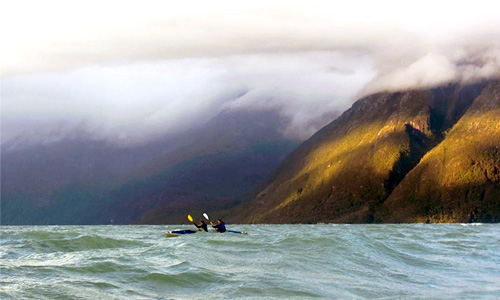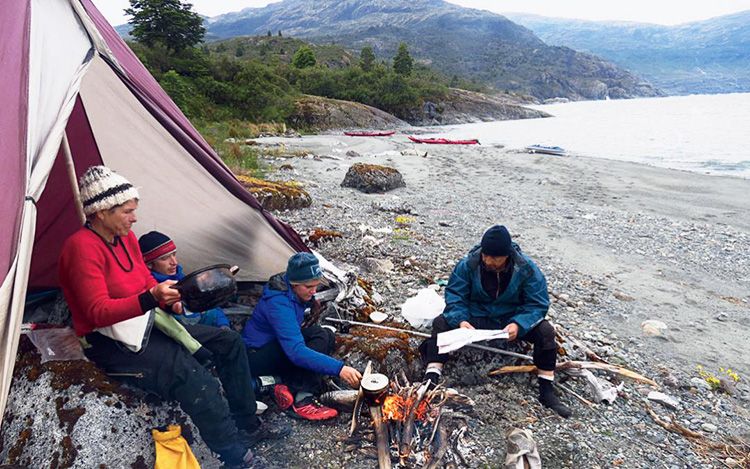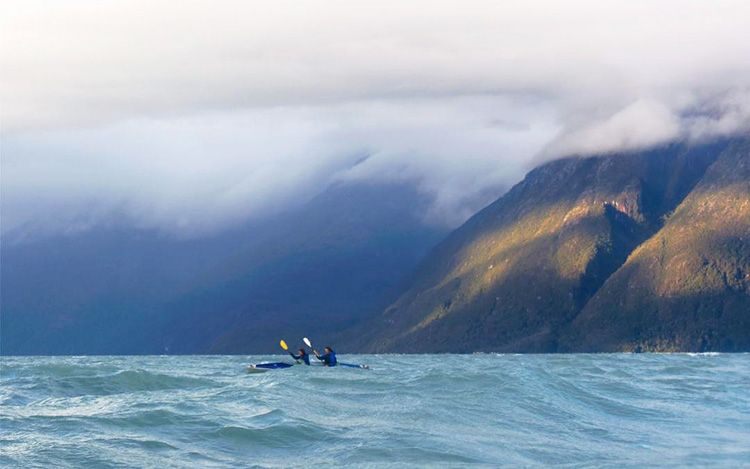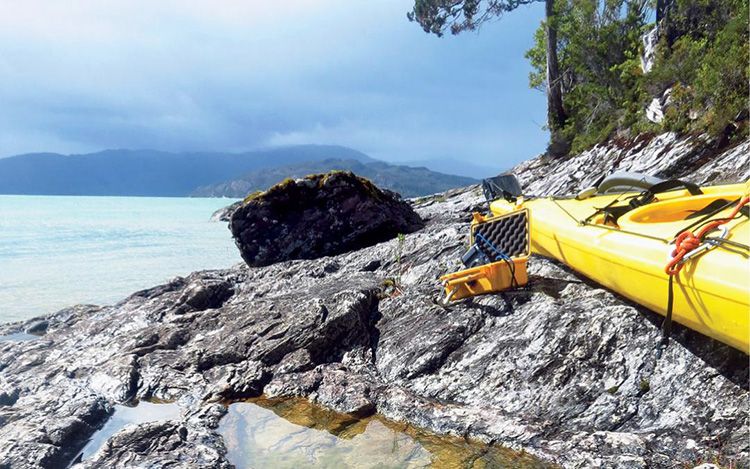

After four hours of struggling against the wind, we ducked into a protected cove where iridescent clumps of ice emerged from the dark water—sedan-size pieces of glacier that had calved off from a tongue of the Southern Patagonian Ice Field. Most of the mountains had darkened by that time, except for one ridge behind us that was gilded by the only shaft of sun we had seen all day.
We paddled toward the coast, to where a few of these icebergs were beached on the front lawn of an abandoned ranch. Aysén is a ranching region, settled by homesteaders in the early 20th century, when border tensions with Argentina led the Chilean government to give away free land. Though more and more Ayséninos are moving to towns and making a living from tourism, the region remains a gaucho stronghold. These hardy souls live the life that many people hope will continue but few people want to live themselves.
We poked around the ranch—walking around the sagging fence that surrounded the cabin, pushing through the overgrown bushes, peeking into the shed where the family once hung their meat. Richard White, a Stanford environmental historian, has written that outdoor recreation like kayaking and mountaineering represents a type of “rugged play” that mimics the hard life of the pioneer. We gringos were trying to re-create the experience of those early gaucho pioneers—only we were doing it for entertainment rather than survival.
This rugged play demands that we use our bodies to move through the land until our thighs quiver and burn, our calves tighten and tire. It also demands that we look closely at whatever is around us: rapids and waves, discoloration and indentations in snow-covered ice, the outcroppings and contours of rock. We often feel closest to the land when it requires attention and labor from us and so such play is a way of reconnecting to the Earth. Among those of us who work with papers and pens, screens and keyboards, rugged play represents a kind of nostalgia. It’s a yearning for the days when we knew the land the way the family at this ranch would have—when we knew it because we had to know it, when we knew it with our bodies.
My musings were swept away by the immediate demands of hunger, cold and fatigue. We set up our nylon tents near the old wooden buildings, made fire and food on the beach and slept.
We woke the next morning to wind hurtling over the water. The waves were even larger than they had been the day before. We set out, making spurts of progress up the coastline. I had a plane to catch in four days, but it was foolish to believe that we could control our rate of progress.

The next several days blurred together: a montage of driving wind and rain, Weston yelling at me whenever my hood wasn’t up and paddling furiously whenever the wind abated. We hung around on beaches when the weather was especially bad, then got back in our boats during the small openings when the wind died down.
One morning, we reached a beach at the tip of the string of islands we had been following since leaving the icebergs. The beach faced a seven-mile open crossing. The weather remained windy and wavy, with whitecapped water and biting gusts. There was no way we could head into open water in such conditions, so we waited again.
We knew exactly how much food we had left: two rolls of coconut cookies, two packets of saltine crackers, a bag of oatmeal, a bag of pasta, a few pieces of stale bread and three bags of dried milk. The five of us shared half a bag of pasta for dinner.
The next day, the rains fell so heavily and continuously that Lisa and Tyler never took off their dry suits. The rest of us shivered in soaked-through rain gear, holding our pruney hands over a fire, taking turns gathering wood. At one point, Lisa and I walked to a nearby beach and heaved large rocks onto pieces of driftwood, trying to split them, joking that we’d become cavewomen.
None of us mentioned our hunger. We had chosen to give up control and there was nothing we could do now but wait out the wind. We were all elated that night when Roberto caught a small fish. I ate the head—including the eyes. Tyler, who doesn’t smoke, asked for one of the cigarettes we had brought as gifts for gauchos. He thought it would lighten the mood.

In the beginning of the trip, when optimism and awe had reigned, we’d fondly nicknamed each snacking and sleeping spot. Tranquilo Bay. Love Beach. We dubbed this waiting spot Desolation Cove.
The next morning, hope displaced our desolation. Smaller waves passed by, free of whitecaps. We packed up our gear and readied our boats in silence, pointing our bows toward the lanky waterfalls and forested mountains that we could see across the open water. New snow dusted the peaks.
We crossed the previously treacherous passage with ridiculous ease, aiming toward a gap between the continent and an island. The seven miles passed quickly. We soon entered a protected channel, drifting by misty cascades and a curving coastline, enjoying Roberto’s secret stash of lollipops and opening up the two emergency rolls of coconut cookies. We were giddy with proximity. There were no more open crossings between us and Tortel. We guessed that we would make it to town that evening.
Midmorning, we spotted a gray wooden boat in a cove. Since reaching the mouth of the Pascua, we’d seen some detritus left from human activity on a few beaches—two deserted and collapsing cabins, empty gas canisters in the sand, rusty nails in pieces of beached wood—but this boat seemed to signal that someone was close by. A tin roof caught light between the trees. We could see chickens and dogs moving about, laundry swinging from a line and smoke puffing from a chimney.
A couple stood outside the house, both wearing black rubber boots and baggy pants. We landed and walked up to their cabin. The man had a mustache, a hat and a tentative posture. The woman had a wide smile and thick hair that fell around her ears. She exuded enthusiasm as soon as we introduced ourselves, ushering us into her house for mate, the ubiquitous South American tea sipped through a metal straw and apologizing for the mess. They didn’t get many visitors, she said.
It was a simple one-room cabin with a wood-burning cookstove in the corner. In another corner, clothes were piled on top of a mattress. Newspaper, pieces of cardboard and a poster of the Virgin Mary covered the walls. A flattened cat food box was pressed against the door and often flapped, letting the wind enter. We sat shivering around the stove, swallowing mate, then bread, then rice, then fish. I was awed by the intense abundance; even the plate was warm. I went back for more.

We described our trip to the couple. The woman nodded. She told us that she’d grown up on the unoccupied ranch near the Jorge Montt Glacier—the ranch where we’d camped next to icebergs. She’d had to cross from there to Tortel many times as a child. It was the route her family had taken to get to town.
When we described Desolation Cove, she nodded again, adding that the wind always blew hard there. Once, she said, she had waited at that spot for seven days before she could cross the channel. Often, gauchos would wait together on that beach, all on their way to Tortel and all stopped by the wild winds of the open channel. Many would bring lambs in their boats for beachside asados. They would make tortas in the sand.
What many in Cochrane had warned us would be a lethal journey was, for the gauchos, just part of their routine. Our rugged play had once been someone’s commute.
In the following days, after we reached Caleta Tortel, forces other than wind, weather and water would take control. I’d hitchhike hundreds of miles to the nearest airport, try to weasel my way onto an interhemispheric flight and apologize to my professors for being late to a new semester. I’d be quickly jolted back into a life of papers and pens, screens and keyboards, showers and email and a bed.
But those gauchos, of course, would stay and often I would think of them: still there, watching the water, waiting out the weather, intertwining their lives with the land and paying close attention to its details. I was only a visitor to that place the gauchos call home, but paddling was my way of weaving the land and sea into my life. Beyond the picture of a place, the postcard version of it, was the possibility of participation.
Salvation for the Pascua
When my friends and I kayaked the lower reaches of the Pascua River in early 2014, we thought we were undertaking a kind of farewell adventure. For eight years, Chilean environmentalists and their international allies had been fighting to prevent the construction of five dams on the Pascua and Baker Rivers. Many people feared that the dams were a done deal and that these wild rivers—gems of rugged Patagonia—would become reservoirs.
Then a massive citizens’ movement overturned the political conventional wisdom. Anti-dam protests in Chile’s south and marches in the capital, Santiago, made the dams a major issue in the 2014 presidential campaign. Not long after President Michelle Bachelet came into office, her cabinet voted to cancel the dams.
The decision was a landmark victory for Chile’s environmental movement. Today, the Pascua and Baker Rivers continue to flow freely.
YOU MIGHT ALSO LIKE
5 Reasons to Explore the Untamed Beauty of Denali National Park
Love Wildlife? Check Out These 11 Stunning Photos From Yellowstone National Park

 233k
233k  41k
41k  Subscribe
Subscribe 